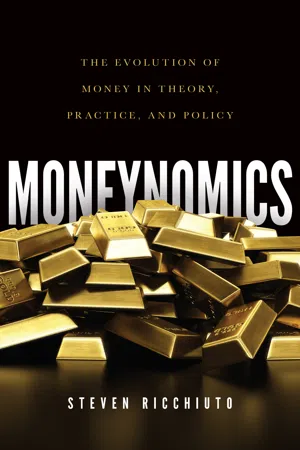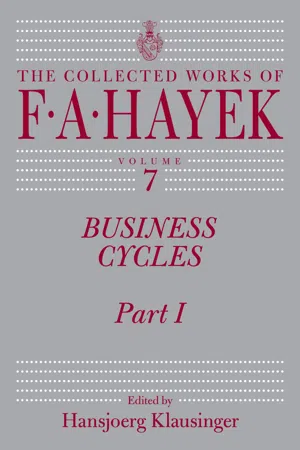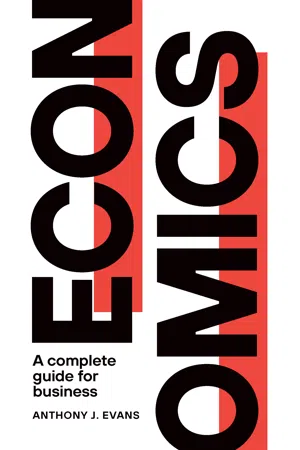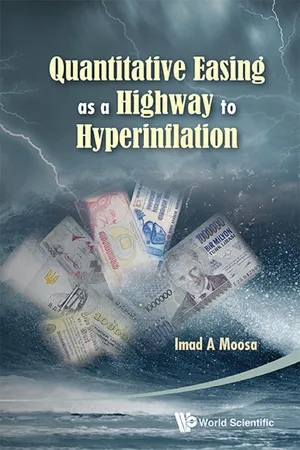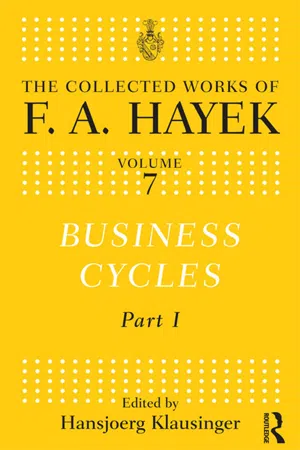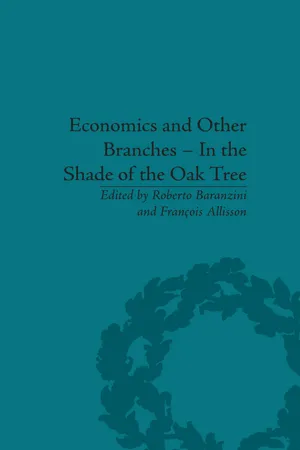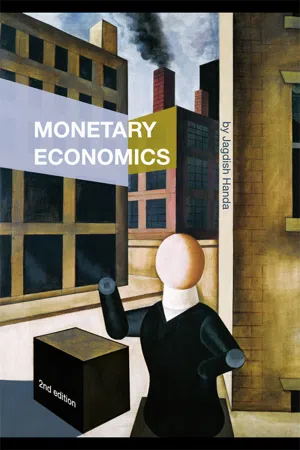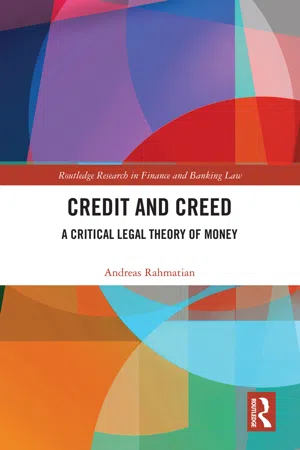Economics
Monetary Theory
Monetary theory is a branch of economics that focuses on the role of money in the economy. It examines how changes in the money supply, interest rates, and central bank policies impact inflation, employment, and economic growth. The theory also explores the relationship between money, prices, and output, and how monetary policy can be used to stabilize the economy.
Written by Perlego with AI-assistance
Related key terms
Related key terms
1 of 4
Related key terms
1 of 3
10 Key excerpts on "Monetary Theory"
- eBook - ePub
- Kenneth K. Kurihara(Author)
- 2013(Publication Date)
- Routledge(Publisher)
PART ONEMonetary Theory AND POLICYPassage contains an image
[CHAPTER ONE ]The Theory of a Monetary EconomyDudley Dillard“… money is the father of private property.”—Max Weber, General Economic History.MONEY is the central concept in the economics of John Maynard Keynes. Viewing his work as a whole, this proposition seems hardly debatable. With respect to his general theory of employment, it may be less obvious, although the title of his book, The General Theory of Employment, Interest and Money, is primafacie evidence that money, along with interest, is the key to his explanation of employment. The present essay examines the hypothesis that the properties of money constitute the ultimate theoretical basis in Keynes’ analysis for the tendency of the economic system to reach equilibrium at less than full employment. This idea is discussed in terms of the origin, evolution, exposition, evaluation and possible further development of what Keynes calls The Theory of a Monetary Economy, or alternately, A Monetary Theory of Production. Although the modern theory of income and employment was stimulated mainly by Keynes, it has departed from his primary emphasis on money. Consequently the present essay has meaning in relation to a clear distinction between Keynes’ own theory and what is often referred to as Keynesian economics, that is, the modern theory of income and employment which uses Keynes’ tools, in refined form, but departs from his fundamental thought, as here interpreted.Although this essay is mainly concerned with an interpretation of Keynes’ fundamental thought, as distinguished from the apparatus in terms of which this thought is expressed, the fact that he was a person of exceptional ability and perspicacious insight suggests the fruitfulness of pursuing further the original direction of his thought. In the vast literature on Keynes almost no recognition has been given to his Theory of a Monetary Economy, and the concept has not been developed anywhere. Keynes’ most important statement of the task to be performed by such a theory appears to be largely unknown to the contributors to Keynesian literature in English, perhaps because the essay in which this was elaborated appeared in a German volume in 1933.1 - eBook - ePub
Moneynomics
The Evolution of Money in Theory, Practice, and Policy
- Steven Ricchiuto(Author)
- 2020(Publication Date)
- Greenleaf Book Group Press(Publisher)
The evolution of macroeconomic thinking since the Great Depression can be divided into three major periods: (1) the Keynesian period; (2) the monetarist period; and (3) the New Keynesian period. Money plays a unique role in each of these views of how the economy functions and, as a result, so does monetary policy. However, instead of focusing on the Fed, as most studies tend to do, the remainder of this book will review money: its role in the economy; the different forms it has taken; the different monetary systems that have been employed domestically; the role of the reserve currency; and how currency valuations are determined, at least in theory. The intent is to fill in the missing pieces in a literature rich in analyses of the Fed and its role in controlling money, interest rates, and the economy, but which is limited in analyzing a primary target of Fed policy and macro modeling.We will look, in detail, at the different forms money has taken throughout history and, more important, the types of money used in this country through its relatively short history. Additionally, we look at the different monetary regimes that have been implemented and why they all failed. This analysis will bring us from wampum to today’s fiat currency model. The costs and benefits associated with each of the different currency regimes experimented with over the decades will also be addressed in the next section.We will then look at the more recent economic/monetary developments and how, despite a fully flexible fiat currency model, the risk of deflation is again threatening the economy. Deflation exacerbated the economic contraction of the 1930s. Keynes explained the failure of the classical school of economics and credited the insufficient liquidity provided to the economy by the central bank as a key contributor to the Depression. In contrast, global excess supply appears to be the culprit behind today’s deflation concerns, suggesting that economic policy may again be at a crossroads, requiring the adoption of new policy tools or at least a new, more coordinated use of fiscal and monetary policy to avoid a repeat of past mistakes. - eBook - ePub
Business Cycles
Part I
- F. A. Hayek, Hansjoerg Klausinger(Authors)
- 2012(Publication Date)
- University of Chicago Press(Publisher)
What I complain of is not only that this theory in its various forms has unduly usurped the central place in Monetary Theory, but that the point of view from which it springs is a positive hindrance to further progress. Not the least harmful effect of this particular theory is the present isolation of the theory of money from the main body of general economic theory. 4 For so long as we use different methods for the explanation of values as they are supposed to exist irrespective of any influence of money, and for the explanation of that influence of money on prices, it can never be otherwise. Yet we are doing nothing less than this if we try to establish direct causal connections between the total quantity of money, the general level of all prices and, perhaps, also the total amount of production. For none of these magnitudes as such ever exerts an influence on the decisions of individuals; yet it is on the assumption of a knowledge of the decisions of individuals that the main propositions of non-monetary economic theory are based. 5 It is to this ‘individualistic’ method that we owe whatever understanding of economic phenomena we possess; that the modern ‘subjective’ theory has advanced beyond the classical school in its consistent use is probably its main advantage over their teaching. If, therefore, Monetary Theory still attempts to establish causal relations between aggregates or general averages, this means that Monetary Theory lags behind the development of economics in general. In fact, neither aggregates nor averages do act upon one another, and it will never be possible to establish necessary connections of cause and effect between them as we can between individual phenomena, individual prices, etc. I would even go so far as to assert that, from the very nature of economic theory, averages can never form a link in its reasoning; but to prove this contention would go far beyond the subject of these lectures - eBook - ePub
Economics: A Complete Guide for Business
A Complete Guide for Business
- Anthony J. Evans(Author)
- 2021(Publication Date)
- London Publishing Partnership(Publisher)
You should realize that the two are the same, but think about how you would feel under each scenario. People are typically more hostile to scenario 2. And since employers recognize this, they are reluctant to cut nominal wages. The system-wide inflation generated by the central bank will mean that economy 2 is more flexible. The Bank of England are essentially doing the dirty work of your boss.8.2Monetary policyMonetary policy is the process by which the monetary authority manages the money supply, and the chief mechanism is through interest rates. The main aims tend to be monetary stability , which is often defined as (i) low inflation and (ii) confidence in the currency. The macroeconomy is a complex system with many interrelated variables. Indeed the reason many students get confused by macroeconomics is because they cannot “see” how those variables interact. Attempting to do so is a pointless task though; it is far too complex to comprehend. The goal of macroeconomics can never be to truly “understand” the economy. To try to simplify things, Table 8.2 shows a list of economic variables split into whether they are a “tool” that the monetary authority can attempt to use, or a “target” that they may wish to control.It used to be the case that the monetary authority would attempt to deliver numerous objectives and be given a fairly large amount of scope in terms of how they went about doing so. But there is a dismal track record of failure. Generally speaking the use of “discretion” became superseded by the adherence to publicly known “rules”. Since we do not have confidence in policymakers’ ability to fine-tune the economy we only grant them the ability to act within the constraints of clear frameworks. Also, such rules reduce uncertainty about what actions central bankers may take, and therefore help manage expectations. We can list some of the more famous monetary policy rules. - Imad A Moosa(Author)
- 2013(Publication Date)
- WSPC(Publisher)
Chapter 3 THE Monetary Theory OF INFLATION 3.1.IntroductionThe idea behind the Monetary Theory of inflation is simple. If more money is created than what is required to buy goods and services, prices will rise — that is, the value of money in terms of goods and services (or the purchasing power of money) will decline. Inflation, in other words, arises when too much money chases too few goods. In the 19th century, the relation between the money supply and inflation was articulated by Joplin (1826) as follows:There is no opinion better established, though it is seldom consistently maintained, than that the general scale of prices existing in every country, is determined by the amount of money which circulates in it.In the 20th century, Milton Friedman appeared as the most outspoken advocate of the Monetary Theory of inflation. A famous quote from Friedman that is often repeated in the literature and the media is that “inflation is always and everywhere a monetary phenomenon” (Friedman, 1963).An increase in the quantity of money is typically taken to be synonymous with the debasement of the medium of exchange. Episodes of debasement have occurred throughout history and involved different forms of money. For example, when gold was used as a currency, the government could collect gold coins, melt them down, mix them with cheaper metals (such as silver, copper or lead), and re-issue them at the same nominal value. By diluting gold with other metals, the government could issue more coins without increasing the amount of gold required to make them. The government profits from an increase in seigniorage (which is the difference between the nominal value of a coin and the cost of producing it), when the cost of producing coins is reduced in this way. As a result, the value of coins declines in terms of goods while goods’ prices rise, which means that monetary inflation leads to price inflation.- eBook - ePub
Business Cycles
Part I
- F.A. Hayek, Hansjoerg Klausinger, Hansjoerg Klausinger(Authors)
- 2020(Publication Date)
- Routledge(Publisher)
40 which, in any case, we are compelled to assume in studying them. The special advantages of the monetary approach consist precisely in the fact that, by starting from a monetary disturbance, we are able to explain deductively all the different peculiarities observed in the course of the Trade Cycle, and so to protect ourselves against objections such as were raised in an earlier chapter against non-monetary theories. It makes it possible to look upon empirically recognised interconnections, which would otherwise rival one another as independent clues to an explanation, as necessary consequences of one common cause.Much theoretical work will have to be done before such a theoretical system can be worked out in such detail that all the empirically observed characteristics of the Trade Cycle can find their explanation within its framework. Up to now, the monetary theories have unduly narrowed the field of phenomena to be explained, by limiting research to those monetary changes which find their expression in changes in the general value of money. Thus they are prevented from showing the deviations of a money economy from a static economy in all their multiplicity.41 The problem of cyclical fluctuations can only be solved satisfactorily when a theory of the money economy itself—still almost entirely lacking at present—has been evolved, comprising a detailed discussion of all those points in which it differs from the equilibrium analysis worked out on the assumption of a pure barter economy. The full elaboration of this intermediate step of theoretical exposition is indispensable before we can achieve a Trade Cycle theory, which—as Böhm-Bawerk has expressed it in a phrase, often quoted but hardly ever taken to heart—must constitute the last chapter of the complete theory of social economy.42 In my opinion, the most important step towards such a theory, which would embrace all new phenomena arising from the addition of money to the conditions assumed in elementary equilibrium theory, would be the emancipation of the theory of money from the restrictions which limit its scope to a discussion of the value - eBook - ePub
Business Cycles
Part II
- F. A. Hayek, Hansjoerg Klausinger(Authors)
- 2012(Publication Date)
- University of Chicago Press(Publisher)
2 money as an essential and ever effective determinant of the course of an exchange economy opens up new vistas: For consequently the course of the economy will never be influenced solely by the natural determinants of the economy and of the distribution of resources, but always as well by the respective regulation of the monetary system, so that—knowing the type of these influences—it can be altered by changes in monetary policy.It is not the subject of this work to explicitly formulate the tasks and goals of monetary policy. This would necessitate far more extensive investigations, and possibly our general knowledge of the most important relationships in question is not yet advanced enough to warrant such an attempt. What can be said preliminarily in this direction is, in my view, best put in the context of a criticism of the ruling doctrine. Yet I believe that even if this investigation cannot contribute anything to a reformulation of monetary policy, it will be justified by the fact that those ill-conceived doctrines which it tries to refute have been put forward in recent years in an extremely dogmatic fashion and have requested a far reaching subordination of policy under the goals propagated on the basis of these doctrines. In the current state of the debate the most important point to be emphasised in this regard would be the demonstration of what small a part of all the shortcomings associated with the use of money can be eliminated by ‘stabilising the value of money’ and that, in addition, other damages emanating from the same source of money may not only be not remedied, but instead reinforced.Thereby the idea becomes obsolete that it must be possible to discern by means of a simple criterion whether there are influences from the side of money on the course of the process of distribution and consequently that money could be regulated in such a way as to avoid such influences. We shall have to accept that such influences will always be present and thus have to restrict ourselves to regulate money in this regard so as to make its effects as favourable as possible. With this insight in mind the postulate of leaving the economy to its own becomes obsolete. - eBook - ePub
Economics and Other Branches – In the Shade of the Oak Tree
Essays in Honour of Pascal Bridel
- François Allisson(Author)
- 2015(Publication Date)
- Routledge(Publisher)
Its interpretation of the essentially monetary nature of inflation, its claims about the likely futility of trying to engender improved real economic performance by pursuing a rising price level, and hence the desirability of making low and stable inflation the central goal of monetary policy, became widely accepted, and remain so today. However, New Classical economics’ so-called ‘monetary surprise’ model of the cycle, which embodied the monetarist hypothesis about the prime importance of variations in the growth rate of the money supply in driving short-run macroeconomic behaviour, did not survive its encounters with empirical evidence, 47 while monetarism’s preferred means of pursuing medium-term price stability – money growth targeting – would also prove fragile when actual policy was based upon it: one such scheme arguably served as a useful cover for the Volcker disinflation of the early 1980s, but the approach was otherwise soon judged impractical in the US, and similar regimes suffered the same fate in many other places too. What then emerged on the policy front under these twin impulses, aided and abetted by Milton Friedman’s spectacularly wrong forecast in 1983–4 that the rapid money growth then in progress would soon lead to a resurgence of inflation, 48 was a sort of ‘Monetarism without money’. 49 The micro-foundations of this new approach were grounded in real business cycle theory, itself drawn from the same tradition in neoclassical growth theory to which Sidrauski had been a seminal contribution, 50 and on the policy front, it retained earlier emphasis on low and stable inflation as a goal and continued to stress the importance of inflation-expectations in models of how to attain it. Crucially, however, it replaced money growth with a nominal interest rate as the central bank’s key instrument - eBook - ePub
- Jagdish Handa(Author)
- 2008(Publication Date)
- Routledge(Publisher)
Part IVMonetary policy and central bankingPassage contains an image
10 Money supply, interest rates and the operating targets of monetary policy
Money supply and interest rates
This is the first of three interrelated chapters on monetary policy and central banking. It starts by examining the goals and operating targets of monetary policy. The two major operating targets of monetary policy are the money supply and the interest rate.This chapter then focuses on the determination of the money supply. While macroeconomic models tend to simplify by assuming that the money supply is exogenously determined, the private sector in the form of the banks, households and firms also influences the money supply.Key concepts introduced in this chapter- ♦ Targeting inflation or its deviation from a desired inflation rate
- ♦ Targeting output and unemployment
- ♦ Interest rate as an operating target
- ♦ Monetary base
- ♦ Currency ratio
- ♦ Demand deposit ratio
- ♦ Free reserves
- ♦ Excess reserves
- ♦ Required reserves
- ♦ Discount/bank rate
- ♦ Mechanical theories of the money supply
- ♦ Behavioral theories of the money supply
This is one of three chapters on some of the central issues of monetary policy. It starts with the relationships among the goals, intermediate targets and operating targets of monetary policy and examines the theoretical justification as well as the implications of adopting different targets. It then considers the issue of whether the central bank should use the money supply or the interest rate as its major monetary policy instrument. It then narrows its focus to the determination of the money supply in the economy, so as to complement the extensive treatment of money demand in the preceding chapters.Sections 10.1 and 10.2 present the links between the goals and targets of monetary policy. Sections 10.3 to 10.5 examine the main operating targets of monetary policy commonly used by central banks and their justification from macroeconomic analysis.1 Sections 10.6 to 10.8 present the determination of the money supply. Section 10.9 covers the application of cointegration analysis and error-correction modeling to money supply. Section 10.10 - eBook - ePub
Credit and Creed
A Critical Legal Theory of Money
- Andreas Rahmatian(Author)
- 2019(Publication Date)
- Routledge(Publisher)
V ) if one seeks to examine the way in which money influences the price of (an aggregate of) individual transactions.131 Mankiw (2013: 93–94). The principal reason is that the newly created money has not (yet) left the banking system and is part of the reserves of the banks. The question whether it is ever supposed to do so, and if so, what the effects are, highlights one of the major points of criticism of the present monetary system, see Chapter 4, sec. 4.132 See Chapter 2.From the point of view of a legal theory of money, the quantity theory of money is of almost no relevance. It cannot explain the legal qualities of money and its economic effects. But that has not been its purpose in the first place: the quantity theory seeks to demonstrate the relationship between quantity of money and price level and inflation – whether it is able to do that is left to economists to discuss.The reason why the classical quantity theory of money has been considered here is because it is the basis of Friedman’s monetarism. Friedman’s theory as such is not particularly relevant to a legal theory of money either. However, it will be discussed now because the principal definitions of wealth in Friedman’s monetarism, and on the other hand the legal concepts of money and dematerialised property advanced here, have certain similarities, although my own conclusions are entirely different from Friedman’s.Friedman restates (and in effect qualifies) the classical quantity theory of money: the quantity theory is a theory of the demand for money, not of output, or money income, or price level. It has the unusual characteristic of combining the supply of capital and the demand for capital. As with any other goods, the demand for money depends on (a) the total wealth to be held in various forms (equivalent of the budget restraint), (b) the price of and return on this and other forms of wealth, and (c) the tastes and preferences of the wealth-owning ‘units’ (i.e. customers as physical and legal persons).133
Index pages curate the most relevant extracts from our library of academic textbooks. They’ve been created using an in-house natural language model (NLM), each adding context and meaning to key research topics.
Explore more topic indexes
Explore more topic indexes
1 of 6
Explore more topic indexes
1 of 4

